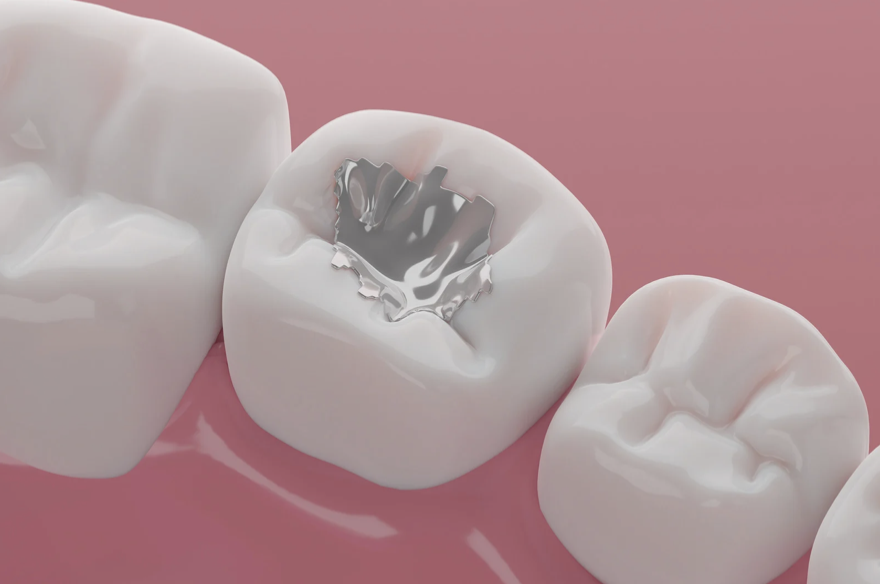
Do you remember the days when you could easily tell when someone had a dental filling because you could see a piece of silver in their mouth when they smiled? While those silver (amalgam) fillings are not as common as they once were, they still exist.
But what exactly are silver dental fillings, and why do we not see them as much we used to?
Keep reading!
What are dental fillings?
Before we get into the specifics of silver dental fillings, let’s talk about what dental fillings are in general. Dental fillings are materials that are used to restore or repair teeth. When you have decay in your teeth (a cavity), dentists remove the decayed part of the tooth, clean the area, and then “fill” it with a material like composite resin, amalgam, or porcelain. This restores the tooth’s shape, and prevents further decay. Another reason dentists use fillings is to repair cracked, broken, or worn down teeth.
What are silver (amalgam) dental fillings?
Silver fillings are fillings made from amalgam. For a long time, they were the most commonly used type of filling. A major benefit of silver fillings is that they can last for 15 or more years. In recent years, though, they aren’t used as much. The main reason? They don’t look natural because teeth, of course, aren’t silver-colored.
What are white (composite) dental fillings?
Composite fillings, on the other hand, are fillings made of composite, which is a mixture of acrylic resin reinforced with powdered glass filler. Composite is not just used for fillings but for a variety of dental restorations such as veneers, inlays, and crowns. They are also sometimes used to repair broken or chipped teeth. The benefit of composite is that it can be customized to match your tooth color, so they are almost unnoticeable to the eye.
Benefits of composite fillings over silver fillings
While the most obvious benefit of composite fillings is that they can keep your smile looking natural looking, without the dark spots that come with silver fillings, there are actually many other benefits of composite, which is why we use them for our fillings. Here are a few.
Composite fillings can save more of your tooth
One of the perks of composite fillings is that compared to other materials, sometimes less tooth structure needs to be removed when removing decay. This is because while composite can bond directly to the tooth, more of the tooth often has to be removed to make a large enough space to hold a silver filling.
Composite fillings are more versatile
Another benefit of composite fillings is that they are more versatile. They can be used to repair chipped, broken, or worn teeth. For example, if you have a front tooth that is chipped or broken, which can be seen when you talk or smile, your dentist might use a composite filling to correct this cosmetic issue.
Composite fillings look more natural-looking
While we mentioned this benefit already, it’s worth mentioning again. Composite fillings are the far superior aesthetic choice when it comes to dental fillings. They can be matched to your tooth so that the filling is virtually invisible. Silver fillings, on the other hand, stand out against your natural tooth color and are far less discreet. And since most of us want the best possible smile we can have, its clear composite is the obvious choice when it comes to aesthetics.
Composite fillings don’t contain mercury
There has been a long debate over the fact that amalgam fillings contain mercury, which releases low levels of vapor containing mercury that can be inhaled and absorbed by the longs. While exposure to mercury vapor in high levels can have adverse effects on the brain and kidneys, studies have found no link between amalgam fillings and health issues, and they are considered safe for adults and children over six years old by the FDA.
However, it’s worth mentioning that composite fillings contain no mercury, so this debate is not even necessary if you have composite fillings.
The drawback compared to silver fillings: they don’t last as long
One drawback of composite fillings compared to silver fillings is that they don’t last as long. While silver fillings can last about 15 years, composite fillings only last for about 7 years on average. However, smaller composite fillings and maintaining good oral health can make your filling last 10 years or more, according to research.
Visit Dr. Ruiz & Associates, Inc for a dentist in Burbank
If you’re in the Burbank area and need a dental filling (or other dental filling), come visit our dentist office in Burbank, Dr. Ruiz & Associates, Inc. Dr. Ruiz is a renowned dentist, educator, and researcher who is known as a pioneer in supra-gingival minimally invasive dentistry, or “above the gums dentistry.” This is a healthier form of dentistry that protects soft oral tissues and produces long-lasting, beautiful results. And all of our staff are trained in these techniques. Check out our Google reviews and schedule an appointment with us today!




